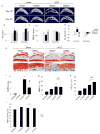Inhibition of TGF-β signaling in mesenchymal stem cells of subchondral bone attenuates osteoarthritis
- PMID: 23685840
- PMCID: PMC3676689
- DOI: 10.1038/nm.3143
Inhibition of TGF-β signaling in mesenchymal stem cells of subchondral bone attenuates osteoarthritis
Abstract
Osteoarthritis is a highly prevalent and debilitating joint disorder. There is no effective medical therapy for the condition because of limited understanding of its pathogenesis. We show that transforming growth factor β1 (TGF-β1) is activated in subchondral bone in response to altered mechanical loading in an anterior cruciate ligament transection (ACLT) mouse model of osteoarthritis. TGF-β1 concentrations are also high in subchondral bone from humans with osteoarthritis. High concentrations of TGF-β1 induced formation of nestin-positive mesenchymal stem cell (MSC) clusters, leading to formation of marrow osteoid islets accompanied by high levels of angiogenesis. We found that transgenic expression of active TGF-β1 in osteoblastic cells induced osteoarthritis, whereas inhibition of TGF-β activity in subchondral bone attenuated the degeneration of articular cartilage. In particular, knockout of the TGF-β type II receptor (TβRII) in nestin-positive MSCs led to less development of osteoarthritis relative to wild-type mice after ACLT. Thus, high concentrations of active TGF-β1 in subchondral bone seem to initiate the pathological changes of osteoarthritis, and inhibition of this process could be a potential therapeutic approach to treating this disease.
Figures








Comment in
-
Osteoarthritis: TGF-β overload at bones of cartilage degeneration.Nat Rev Rheumatol. 2013 Jul;9(7):382. doi: 10.1038/nrrheum.2013.81. Epub 2013 May 28. Nat Rev Rheumatol. 2013. PMID: 23712126 No abstract available.
-
TGF-β and osteoarthritis--the good and the bad.Nat Med. 2013 Jun;19(6):667-9. doi: 10.1038/nm.3228. Nat Med. 2013. PMID: 23744142 No abstract available.
References
-
- Hootman JM, Helmick CG. Projections of US prevalence of arthritis and associated activity limitations. Arthritis Rheum. 2006;54:226–229. - PubMed
-
- van den Berg WB. Osteoarthritis year 2010 in review: pathomechanisms. Osteoarthritis Cartilage. 2011;19:338–341. - PubMed
-
- Berenbaum F. Osteoarthritis year 2010 in review: pharmacological therapies. Osteoarthritis Cartilage. 2011;19:361–365. - PubMed
-
- Hawker GA, Mian S, Bednis K, Stanaitis I. Osteoarthritis year 2010 in review: non-pharmacologic therapy. Osteoarthritis Cartilage. 2011;19:366–374. - PubMed
-
- Saito T, et al. Transcriptional regulation of endochondral ossification by HIF-2alpha during skeletal growth and osteoarthritis development. Nat Med. 2010;16:678–686. - PubMed
Publication types
MeSH terms
Substances
Grants and funding
LinkOut - more resources
Full Text Sources
Other Literature Sources
Medical
Molecular Biology Databases

